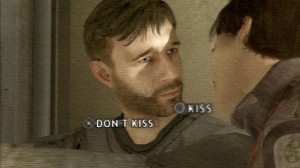Far Cry Cover Art Gives Unhappy Feels
This week Ubisoft tangentially announced the follow-up to 2012’s Far Cry 3 by way of a piece of leaked cover art – or rather it would have been the game’s cover art were it not for the hand-wringing arsetardery of the industry’s faux-moral custodians, as one gets the sneaking suspicion that Ubisoft may now opt for box-art which elicits less in the way of fake controversy. The cover itself depicts an individual who is clearly intended to play the game’s villain reclining over a native who has adopted a subservient position. The problem that the internet’s social justice buffoons had with the image was that the villain’s skin tone was a few shades lighter than that of the native and his hair is bleach blonde, which the usual cavalcade of mongtards chose to interpret as him being a white man, and led to myriad nauseating cries of “that’s racist“! Never mind the fact that Far Cry 4‘s villain is clearly depicted with Asian characteristics, the internet’s social justice warriors deemed him to be white by way of comparison, and thus as Anglo as freedom and warm apple pie in much the same way as the Zimzam was cast as white on account of his skin tone being lighter than that of the hoodlum he apprehended.
So the skin tone of the villain was lighter than that of his helper-monkey, and the internet overreacted as the internet is wont to do, then like clockwork Ubisoft developer, Alex Hutchinson, had to take to Twitter to point out the bleeding obvious to these gibbering simpletons:
“Just so it’s clear for those jumping to conclusions: He’s not white and that’s not the player.”

The social justice crowd tend to be selfish to a fault, and have the racially aware sophistication of potatoes.
Right, so the premise of the rabble’s social justice butthurt was now thoroughly debunked. The cover would still have been one hundred percent sound if it had featured a white person since the villain is being cast in a decidedly negative light, yet the villain is not even white which means that the cover cannot be racist on account of the immutable fact that only white people do racism [sarcasm]. This would have been the point at which this nontroversy could have ended if we lived in a sane world, yet funnily enough these social justice busybodies decided that their best course of action was to carry on blaming Ubisoft for their initial failure of comprehension and subsequent overreaction. Kotaku’s Nathan Grayson, contrary to any visual evidence, maintains that Far Cry 4‘s villain is nevertheless “ostensibly white“, and says that the nontroversy is all Ubisoft’s fault for not providing racial context [other than what is clearly visually perceptible] for the image they released – essentially chiding them for not providing a trigger warning for depicting persons of lightish coloured skin.
Heaven forefend Ubisoft should fail to play to the inherent racism of the social justice bandwagon! Trigger warnings were originally utilised by medicine and psychology as a mechanism by which sufferers of PTSD could avoid reading information which would potentially trigger their malady, rather than as a measure to safeguard the feels of the oversensitive. It is not the purpose of trigger warnings to coddle the sensibilities of people too thick to tell the difference between a white man and someone of a light-skinned Asian appearance; and to abuse them so as a trapping of this Tumblr-fueled mental infirmity only serves to make a mockery of a legitimate mechanism used by the sufferers of PTSD within the very specific context of medical literature. Moreover, these nagging ninnies do not even attempt to account for the fact that it is prohibitively difficult for rational people to be able to predict the actions of irrational people, meaning that any sensible software developer would not be able to adequately self-police this kind of thing anyway. The primary outcome that this sort of harassment is likely to have on the game industry is that it will impose a chilling effect on the use of direct lines of communication between the developer and the consumer, as developers opt to filter everything through PR agencies. This might sound like a progressive utopia to idiots, yet it stands to be a very bad thing for rank and file gamers.
Trapped In a Glass Cage of Emotion
Ever since Peter Molyneux left his job at Microsoft and exited the limelight [somewhat], it has been almost uncanny the way that David Cage has been able to step in and fill the vacuum of stupid left in his wake. Cage has long been known as a would-be auteur who produces software which would scarcely be considered games in service of utilizing the medium to convey a narrative, while paradoxically being a terrible writer who creates narratives that are just full of holes. Whether it be the tale of a concerned detective who remembers at the eleventh hour that he’s supposed to be a serial killer, or the exploits of a young girl and her invisible friend which are chronologically fragmented and presented at random. Whatever the game, one thing remains certain; at some point you will be forced to sit through an awkwardly and awfully enacted sex scene [by way of directorial motif] which serves to make the trysts of Team America appear almost natural by comparison.
This week Cage has again been in fine form, claiming that the industry is apt to produce naught but children’s fancies, while his games alone are the sole bastion of meaning amid the common swill – without even the faintest acknowledgement of the hypocrisy inherent to his position.
“By far, video games are the most fascinating medium that mankind has ever created. They have the power to make you think in ways that films and books have not achieved.
At the moment, we use video games as a toy, but they have the potential to be meaningful.”
In all fairness to Cage, one is readily willing to concede that the majority of games currently being produced err to frivolity rather than deep narrative, but to chatacterise the entire medium thusly is to betray one’s ignorance of the games currently being produced in the indy realm, but whatever. This sentiment by itself is fairly innocuous, but as Cage goes into specifics things become manifestly worse.
“My opinion is that we have nothing in games that gets anywhere near to a good film in terms of narrative or characterization. Games focus on simple themes and target a teenage audience. They could become meaningful. They could have the power to move a larger audience. But it would take new paradigms, a shift to privileging meaning over action and a lot more power given to talented people for that to happen.
See, our industry has defined interactivity as performing physical actions, like shooting or jumping, in loops. So, for many people, my games are not real video games because they don’t fit into this restrictive idea of interactivity. My characters don’t carry guns or shoot every person they meet. They lead normal lives and do mundane things. They have emotions and relationships. This, to me, is what interactivity is about–creating real empathy between a player and their character. But games are a conservative industry. It’s hard to convince hardcore players to accept these new kinds of interactivity.”
With this comment Cage clearly revealed that he is staggeringly ignorant of the type of games that are being produced for the mass video game market. Sure, the interactivity of games is most frequently used to perform actions, as the medium would be pretty bloody dull otherwise, yet Cage is too lost in his own myopic little film-obsessed world to even notice that there is a huge demand for player agency within the telling of a game’s narrative. Satisfying action mechanics and interactive storytelling are not mutually exclusive in most games, though they are in games that are produced by David Cage. When Mass Effect 3 betrayed player agency the outcry was so great that Bioware had to create an entirely new ending for the game, though at least the original
Nintendo Turns Off the Wii
As the PS3 and 360 continue to receive strong triple-A support from third party developers it feels a little funny to think of Nintendo’s long-dead Wii console, the last model of which has long ago rolled off the assembly line [barely outliving Sony’s fifth generation PS2]. This one-trick pony of a console ostensibly won the seventh generation of console sales, yet it has not been supported since around 2010 when Nintendo dumped it like an unwanted baby into a mall dumpster.
This week will see Nintendo permanently shut off access to all Wi-Fi services belonging the DS, DSi, Wii’s library of games. This will see important components vanish forever from popular games such as Mario Kart Wii, Mario Kart DS, Super Smash Bros. Brawl, Dragon Quest IX, and many more. When the lights go dark on the Wii the situation in which the console will find itself should serve as something of a preview of what is to come for the PS3, 360, and all future consoles. Moreover, it will perhaps serve as an even better dry-run for what to expect when Nintendo drops the Wii U, on account of them both being Nintendo consoles. Nintendo has opted to shut off Wii online services far quicker than Microsoft ever did for the original Xbox, so it is no great stretch of the imagination to predict a shoddy support redux for the Wii U.


